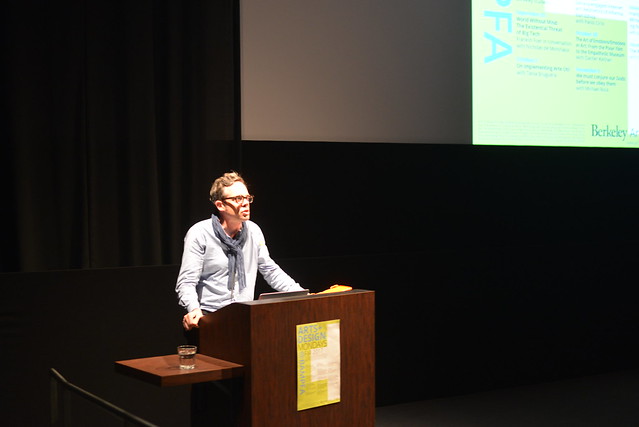ATC Revisited: Michael Rock

Recap by KC Forcier, the 2017-2018 Graduate Liaison for the Art, Technology, and Culture Colloquium
"We Must Conjure Our Gods Before We Obey Them:" Michael Rock on Design and Difference
In the final ATC lecture of the fall semester, Michael Rock, creative director of the influential design firm, 2x4, addressed the series’ 2017 theme of Public (Re)Assembly through the lens of design, arguing that the work of the creative director is always to assemble things into a coherent story. Rock used design principles to explore the ways in which design shapes our visual and lived environment, subtly and profoundly participating in the politics of public life.
In the world of creative design and branding, the role of design is to tell a story that sets a product apart, that underscores difference. In the crowded marketplace of things, the brand design makes meaningful difference between products that are otherwise identical. If, as Rock asserts, “design makes difference visual,” it is a helpful framework for thinking about the formation of identity categories in capitalist society. To discuss how the design of a common product assigns meaning to visual differences, Rock invoked the common example of men’s and women’s razors: “the function doesn’t change, but the story does.”
If design is about visually telling a story of difference, Rock observed the many ways in which design perpetuates fictions of identity. Maps, for example, give meaning to the concept of nation; the architectural design of separate men’s and women’s bathrooms participate in an idea of gender. And, Rock observed, only a generation ago, public buildings were designed with three bathrooms, dividing Americans by race as well as gender. “We understand the world through how it is designed, through our representations of it,” claims Rock.
If design is fundamental to the shaping of categories, Rock poses a fundamental question for the field: “is the designer embellishing an existing system or creating a new one?” What is the role of the designer in sustaining harmful categories, or creating space for new ways of thinking? Rock ended his talk with the example of the constellations - suggesting that civilizations projected stories onto the abstract space of the stars, stories about gods which then came to rule them. If, as Rock asserts, “We must conjure our gods before we obey them,” he suggests there is possibility in design for transformation, and for a radical reimagining of what is possible.

